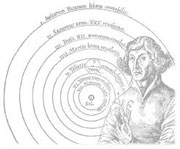 |
Copernicium is named after the astronomer Nicolaus Copernicus. |
Copernicium (ununbium or eka-mercury)
| Atomic Number: | 112 | Atomic Radius: | empirical: 147 pm (predicted)[1][5] |
| Atomic Symbol: | Cn | Melting Point: | -- |
| Atomic Weight: | 285 | Boiling Point: | 357+112−108 K (84+112 −108 °C, 183+202 |
| Electron Configuration: | [Rn] 7s2 5f14 6d10 (predicted)[1] |
Oxidation States: | 2, (1), 0 (parenthesized oxidation states are predictions)[1][4][5] |
History
On February 9, 1996, element 277Cn was created at the Gesellschaft fur Schwerionenforschung in Darmstadt, Germany by using the reaction 208Pb + 70Zn. Unlike element 110, Copernicium has properties more similar to radon than mercury, but due to its short half-life, it is difficult to study. As of 2011, Copernicum's most stable isotope has an atomic weight of 285.
